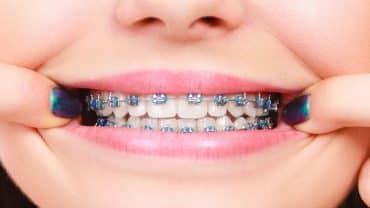How much do braces cost a month? is being broken down. We can only provide a range of estimates in this article. However, we can discuss some of the elements that go into the ultimate cost as well as the various alternatives available for braces.
How Much Do Braces Cost a Month
Where you live is one of the variable elements in braces cost estimations. Orthodontists in major cities typically charge more than rural practitioners in more remote places. In a moment, we’ll break out the monthly charges. However, on average, you can anticipate paying a total of:
Traditional metal braces cost between $3,000 and $7,000.
Braces that are clear or ceramic cost between $4,000 and $8,000.
Braces in various colors ranging in price from $3,000 to $7,000.
$4,000 to $7,400 for Invisalign and Invisalign Teen
A treatment plan will be created for you after your initial session. This includes the overall amount of time it will take to straighten your teeth. The total number of appointments and adjustments you will have depends on the time period. It will also have an impact on the expense of your therapy on a monthly basis. Insurance may cover all or portion of your total expenditure, affecting your monthly payment amount as well.
Many payment options start at $75 to $100 per month as a starting point. More serious alignment issues will cost more in the long run, potentially reaching $300 or more each month. Don’t be alarmed. We’ll go over various options for paying for and defraying the costs of braces.
Different Methods to Pay for Your Braces
Dr Koch and his entire team are serious about assisting you in achieving your ideal smile. Our staff will contact your insurance carrier on your behalf to determine how much of your orthodontic expenditures will be covered by your plan. Despite the fact that dealing with insurance providers is never a precise science, we make every effort to acquire the benefits you are entitled to.
Our office accepts Visa, Mastercard, and Discover in addition to insurance. We offer a 5% discount if you pay in full at the time of treatment. Care Credit offers personal payment plans to borrowers that meet certain criteria. Affordably priced payment options with no interest are also available. At the time of your evaluation, the team at Koch Orthodontics will discuss these and other choices with you. Bring any questions you have (along with your insurance card) to your initial appointment.
If you or your child is on Medicaid, braces may be covered. The braces must be “medically essential,” though. That suggests your alignment issues are interfering with your ability to eat or drink, which has a negative impact on your general health. More information is available on the Medicaid website.
If you have a flexible spending account (HSA, FSA, HRA, or MSA) for medical expenses, you may be able to use some of the funds to help pay for braces. There are a variety of spending plans available, as well as a variety of regulations to follow. If you think this might be an option for you, please check with your savings administrator.
Cost of Metal Braces Vs. Other Types of Braces
Traditional metal braces are the least costly type of braces. As we touched on earlier, metal braces usually cost between $3,000 and $7,000. Other options include:
- Ceramic braces ($4,000 to $8,000), which are tooth-colored. They’re less noticeable than traditional braces, but they’re not quite as durable. Ceramic braces may work faster than the other common, subtle option invisible aligners.
- Invisalign ($4,000 to $7,000) treatment involves a series of clear plastic aligners that gradually move the teeth closer and closer to the target position. Aligners are truly clear, so they’re difficult to detect in everyday situations. They’re removed for eating and drinking, so they may not be a great option for younger children who may not be responsible enough to care for them. The treatment time is typically between one and three years.
- Lingual braces ($8,000 to $10,000) are placed behind the teeth. They carry many of the same benefits as traditional metal braces, but they’re more difficult to clean and require more adjustments.
Traditional metal braces are the most cost-efficient option for families without insurance, but if you’d like to know more about each type, consult your local Kool Smiles partner dentist.
Average cost of braces per month
#1. Traditional metal braces
When you think of orthodontic treatment, you generally think of braces like these. Wires and brackets gradually modify the position of your teeth. This treatment regimen can take anything from a few months to a few years to finish.
If you have moderate to severe alignment concerns, this is usually the most cost-effective alternative. However, because these braces are the most apparent option, several adults and teenagers seek less conspicuous alternatives.
Traditional braces can cost anywhere from $2,500 to $7,500 in total, with an average monthly cost of $200 to $250. Payment plans, on the other hand, can be to offset the expense. If you can pay the whole cost up in advance, your clinic may offer you a discount.
#2. Invisible braces
Invisalign is a clear aligner brand. This is an option you may prefer if you are an adult. There are no wires or brackets, thus they work differently than standard braces. Instead, these are fully transparent, detachable, and far more unobtrusive.
They are pricier than traditional braces, ranging from $3,500 to $8,500 with an average monthly cost of $330 to $500.
If you’re on a tight budget, your orthodontist may suggest a different brand that is less expensive.
At-home clear aligners are a less expensive option to in-office invisible braces. These start at $79 a month and are intended to cure mild to moderate malocclusion.
#3. Other braces
Invisalign and metal braces tend to be the most common orthodontic treatments. However, there are other options.
#4. Lingual braces
The wires for lingual braces are attached behind the teeth. They are the most discreet alternative, but they are also the most expensive, costing up to $13,000. Lingual braces will also necessitate more frequent adjustments. Lingual braces cost between $450 and $650 per month on average.
#5. Ceramic braces
They have the appearance of metal braces, but they are to match your teeth. They are normally a little more expensive than metal ones, with prices ranging from $1,000 to $10,000. Clear ceramic braces are also available. Ceramic braces will cost between $270 and $350 each month.
#6. At-home clear aligners
Remote clear aligners have the lowest average cost of all orthodontic treatments. The average cost for braces treatment a month with clear aligners varies greatly but can be anywhere from $80 to $300 per month.
Reasonable Cost for Adult Braces?
The cost of an adult braces a month treatment regimen varies substantially. Depending on the treatment required and the projected treatment period, it can cost anywhere from $1,500 to $6,000. Most adults, on the other hand, fall somewhere in the middle. To discover more about Premier Orthodontics’ braces prices, click here.
When inflation is into account, braces now cost less than they did when you were in junior high.
Furthermore, when you consider the health issues you’ll avoid, adult braces are one of the best investments you can make.
Consider the following scenario
- Cosmetic dentistry and porcelain veneers that are required to repair chipping and fracturing of teeth caused by a bad bite can cost anywhere from $5,000 – $15,000.
- Many adults have gum disease caused by crowded, hard-to-clean teeth. The gum disease treatment costs are often over $1000 per year.
- Years of living with an unhealthy bite can cause jaw pain, requiring TMJ treatment. This cost, plus the cost of migraine medication can cost thousands of dollars each year.
The cost of “getting by” with tooth and bite problems may end up costing you 20X the investment of adult braces.
When you consider the cost of adult braces, here is everything else that the treatment fees typically cover:
- All braces appointments and office visits
- The actual braces (and any additional appliances that may be needed
- Retainers after your treatment is complete
- And in our office, certain guarantees (like our lifetime guarantee)
How much do braces cost per month without insurance?
For traditional metal braces, the average cost of braces without insurance is from $2,500 to $7,500. These expenses, however, can vary significantly depending on the sort of treatment you choose. It also depends on how long you’ve been receiving treatment. You should discuss the cost with your orthodontist; most of them provide a free consultation.
If you don’t have insurance, your orthodontist is likely to offer monthly payment arrangements. You may be able to request that your payment period be, allowing you to pay less per month for a longer period of time.
Different methods to finance the costs
Your dentist wants you to have good oral health, so they will provide you with advice that is in your best interests. Maximum dentists will work with your dental insurance to ensure that you get the most coverage possible. Braces can also be paid for with a variety of payment methods, including credit cards and monthly payments.
Medicaid should pay for all medically necessary treatments for your children, but treatment coverage for adults is far more limited. Furthermore, Medicaid does not cover all types of braces.
You might be able to deduct the amount from your flexible spending account. HSAs, FSAs, HRAs, and other types of accounts are examples. If your dental insurance plan does not cover treatment, you can use some of the money to reduce your payments.
Are There Free Braces?
Children from families with low incomes who are enrolled in Medicaid, the Children’s Health Insurance Plan (CHIP), or another state-sponsored low-income insurance program may be eligible for free orthodontic care. Different states have different eligibility requirements; some states cover children until they turn 21, while others don’t cover them until they turn 18.
At What Age Are Braces Not Free?
If a patient is under the age of 18 and their dentist believes they could benefit from orthodontic treatment, then the NHS will cover the cost of that treatment. Adults are not often eligible for orthodontic treatment through the NHS; however, approval may be granted on an individual basis if the procedure is medically necessary.
How Long Do Braces Take to Straighten Teeth?
In the vast majority of cases, the process of straightening the teeth using dental braces can be completed in as little as six months or as long as two years. Your orthodontist will be able to provide you with an accurate estimate regarding the length of time your treatment with braces will take based on their previous experience treating patients with requirements that are comparable to your own.
How Do You Brush With Braces?
To begin, tilt the toothbrush so that it is at a 45-degree angle and then brush along the gum line in a circular motion. Next, adjust the angle of the toothbrush so that you can gently brush the tops of your brackets. This will ensure that you have a clean smile. The toothbrush should then be repositioned at an angle up so that it can be used to clean under the brackets and wire. Make sure that each tooth is cleaned.
What Factors Influence the Cost of Braces?
Braces are usually rather costly. However, determining how much it will cost is a more difficult task. Your ultimate bill might be by a number of things. Some are locations, while others are consistent across state lines. We’ll go over each one in-depth below.
#1. Condition Severity
This is the most important aspect in determining price. A modest degree of crowding or spacing requires fewer aligners and time than a severe case of crossbite. The fewer visits to the dentist your teeth require, the less you’ll have to pay. Your dentist/orthodontist can analyze your teeth and give you an estimate of how long your treatment will take at your initial consultation.
#2. Type of Braces
Over the last few decades, orthodontic technology has improved dramatically, and traditional metal brackets are no longer the sole option. You can choose between ceramic braces that blend in with your teeth and lingual braces that sit behind your teeth, for example. Each of these options is less visible than traditional braces, but they are also more costly. Braces made of ceramic can cost up to $8,000, while lingual braces can cost anywhere from $8,000 to $12,000.
#3. Region
Orthodontic treatment is generally more expensive on the coastlines and less expensive in the middle of the country. The northeast is particularly pricey, whereas states in the south, such as Alabama and Mississippi, have some of the lowest expenses in the country. Taxes can also be a factor. The state will add sales tax to the entire cost of your braces, and increasing corporate taxes may prompt your orthodontist to raise costs to compensate.
The Midwest has lower average orthodontic fees than the rest of the country (except the South). Furthermore, because the cost of living in Michigan does not vary greatly between cities, suburbs, and rural regions, you should be able to discover reasonable braces costs no matter where you live. While Michigan may not have as many orthodontists as other states, it still has a good number, so you’ll have plenty of options.
Michigan is surrounded by the states of Ohio, Indiana, Illinois, and Wisconsin (if you live in the Upper Peninsula). If you live near the state’s southern border, you might be able to access better care in Indiana or Ohio, where the cost of living is lower. Just keep in mind that once you start therapy, you’ll need to return to the doctor on a frequent basis. Don’t choose an orthodontist in Indianapolis if you don’t want to drive there every month.
How can I pay monthly for braces?
Your orthodontist’s office will almost certainly offer monthly payment plans and will be able to work out a financing arrangement with you. Many practices collaborate with companies that provide third-party funding. As a result, they are able to provide you with more flexible payment options than traditional financing options.
The majority of orthodontic practices provide interest-free payment plans. Furthermore, payments can be made over a period of up to 24 months.
Naturally, each office will function in a unique way. We recommend scheduling an appointment with your dentist or orthodontist and asking them the following questions:
- What are your payment plan policies?
- Is my child covered by insurance?
- Is there interest in the plan?
- What is the length of time I have to cover the treatments?
- Can I make adjustments to the plan?
- Are there any fees?
- What can I do to save more money?
Do You Lose Weight With Braces?
Experiencing a loss of weight while undergoing adult orthodontic treatment is merely an accidental side effect. Tenderness can be felt on the gums and teeth when teeth are moving around in their sockets. Because of this feeling, it’s possible that you won’t be able to eat as much as you normally would because the initial bite can hurt. It’s possible that your dentist will recommend that you steer clear of consuming certain foods.
Do Braces Thin Your Face?
It depends. When you use braces or Invisalign to alter the alignment of your teeth, the soft tissues that lay over them, such as your cheeks and lips, will adjust to the new alignment of your bite. This is because braces and Invisalign are virtually invisible. Because of this, a person who is without teeth may have the appearance of having a “sunken-in” face.
Do Braces Make Lips Bigger?
It’s possible that wearing traditional braces, which involve a bracket and wire system, will give the impression that your lips are more prominent than they actually are. The increasing width of both your teeth and your lips is to blame for this. Your lips won’t get any wider, but until your braces are removed, they won’t be able to press as heavily against your teeth as they normally would.
Conclusion
Braces therapy can be costly, but there are a variety of options for budgeting. The cost of braces is determined by where you reside, the type of braces you choose, and the difficulty of the removal process. All of these factors contribute to the overall cost of braces.
If you plan to pay for braces without insurance, be sure to discuss your payment options with your orthodontist during your consultation. In most cases, orthodontists will accept payments in monthly installments with no interest.
Whatever you choose to do, your oral health is crucial! Although the hefty expense of braces makes them difficult to afford, keep in mind that they are an investment in your dental and general health.
FAQ
Should I pay for my braces in full?
Paying For Braces Directly. Pay for the whole treatment upfront to get a discount. If you can afford the whole cost of braces upfront, this may be an attractive option. Discounts for paying the whole cost at once vary from office to office, but they’re normally around 3% to 7%.
What age is best for braces?
Some children start their orthodontic treatment as young as six. However, most agree that the best age to get braces or another form of treatment is between the ages of 8 and 14, which is when the head and mouth are most conducive to straightening.
Can you pay braces off?
Unlike many other purchases that may require long lengths of time and hefty monthly payments, braces are a relatively palatable financial obligation. And they can be paid off much more easily and in much less time. Consider in-office financing or third-party financing.







2 comments
Ich möchte meine Zahnfehlstellungen mit einer unsichtbaren Zahnkorrektur korrigieren. Dabei bin ich auf die Variante mit Invisalign gestoßen. Interessant, dass selbst die Region die Mosten einer Zahnspange beeinflussen kann.
Unfassbar, dass manche Kinder bereits mit 6 Jahren eine Zahnspange besitzen. Meine Tochter möchte jetzt ihre erste Zahnspange erhalten. Für nähere Informationen suchen wir uns nächste Woche eine gute Fachpraxis für Zahnspangen.